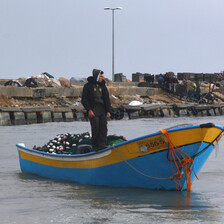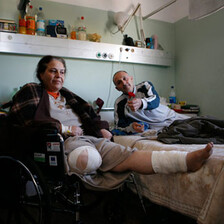The Electronic Intifada 26 January 2009
GAZA CITY, occupied Gaza Strip (IPS) - At 7:30am 22 January, five days after Israeli authorities declared a “ceasefire” following their 22-day air, land and sea bombardment of the Gaza Strip, Israeli gunboats renewed shelling off the Gaza city coast, injuring at least six, including four children.
Muawiyah Hassanain, director of Ambulance and Emergency Services, reported more shelling in the northwestern coastal area al-Sudaniya the same morning. Five fishermen were injured in the attacks, he said.
About 9:45am that morning in Shejaiya district to the east of Gaza City, seven-year-old Ahmed Hassanian was outside his house with friends when Israeli soldiers fired from the eastern border. A bullet lodged in his brain, causing brain hemorrhage. Dr. Fawzi Nablusi, director of the ICU at al-Shifa hospital, says the boy is not expected to survive.
Three Palestinians have been killed since the ceasefire and 15 injured, including the ten injured 22 January, according to both Hassanain and Dr. Khalaf.
Hours after the ceasefire was said to have come into effect 18 January, Israeli warplanes flew extremely low over areas of Gaza. Drones capable both of photographing and of dropping targeted missiles continued to circle overhead. At 8:30am on 18 January, one of these drones dropped two missiles in the Amal area east of Beit Hanoun, killing 11-year-old Angham Rafat al-Masri and injuring her mother.
The Palestinian Centre for Human Rights (PCHR) reports further violations of the ceasefire, including the killing of Maher Abu Rjaila, 23, shot in the chest by Israeli troops at 10:40am 18 January as he walked on his land east of Khan Younis city.
Israeli soldiers fired on residents of Al-Qarara, near Khan Younis, at 1pm 20 January, shooting Waleed al-Astal, 42, in his right foot.
In al-Shifa hospital, Yasser Abed, 15, from Gaza’s Beach refugee camp, explained how he received a shard of shrapnel in his forehead. “I went out of my house to see what was happening,” he said. “I didn’t see the gunboat, didn’t see anything.” His father explains that Yasser was rushed to al-Shifa after the shrapnel hit him, and that there was a girl nearby aged about four who was also hit by a piece of shrapnel.
In another room at al-Shifa, 11-year-old Nisreen al-Quqa tells how she was out walking on the beach with her brother when the Israeli navy began to fire upon Palestinian fishermen. A piece of shrapnel from the shelling got lodged in her right calf muscle. “What ceasefire?” the girl’s mother said, looking down at her daughter. But she knows Nisreen is lucky to have only a minor leg injury; it could have been much worse.
Others injured after the ceasefire include a 14-year-old boy hit in the thigh by shrapnel fragments, and a 35-year-old man also with shrapnel injury.
Israel’s assault on Gaza killed at least 1,330 people, with as many as 200 more bodies expected to be recovered from under the rubble of more than 4,000 destroyed houses and 20,000 buildings.
Ninety percent of the cases in al-Shifa’s ICU are civilian, and of these half are women and children, says Dr. Fawzi.
Ceasefire violations are not new. During the six-month ceasefire that began 19 June, Israeli forces killed 22 Palestinians, many of them members of resistance groups. Thirty-eight fishermen and farmers were abducted.
Israeli soldiers routinely fired upon fishermen and farmers along Gaza’s eastern and northern borders, injuring 62, according to Palestinian sources.
All rights reserved, IPS - Inter Press Service (2009). Total or partial publication, retransmission or sale forbidden.
Related Links





